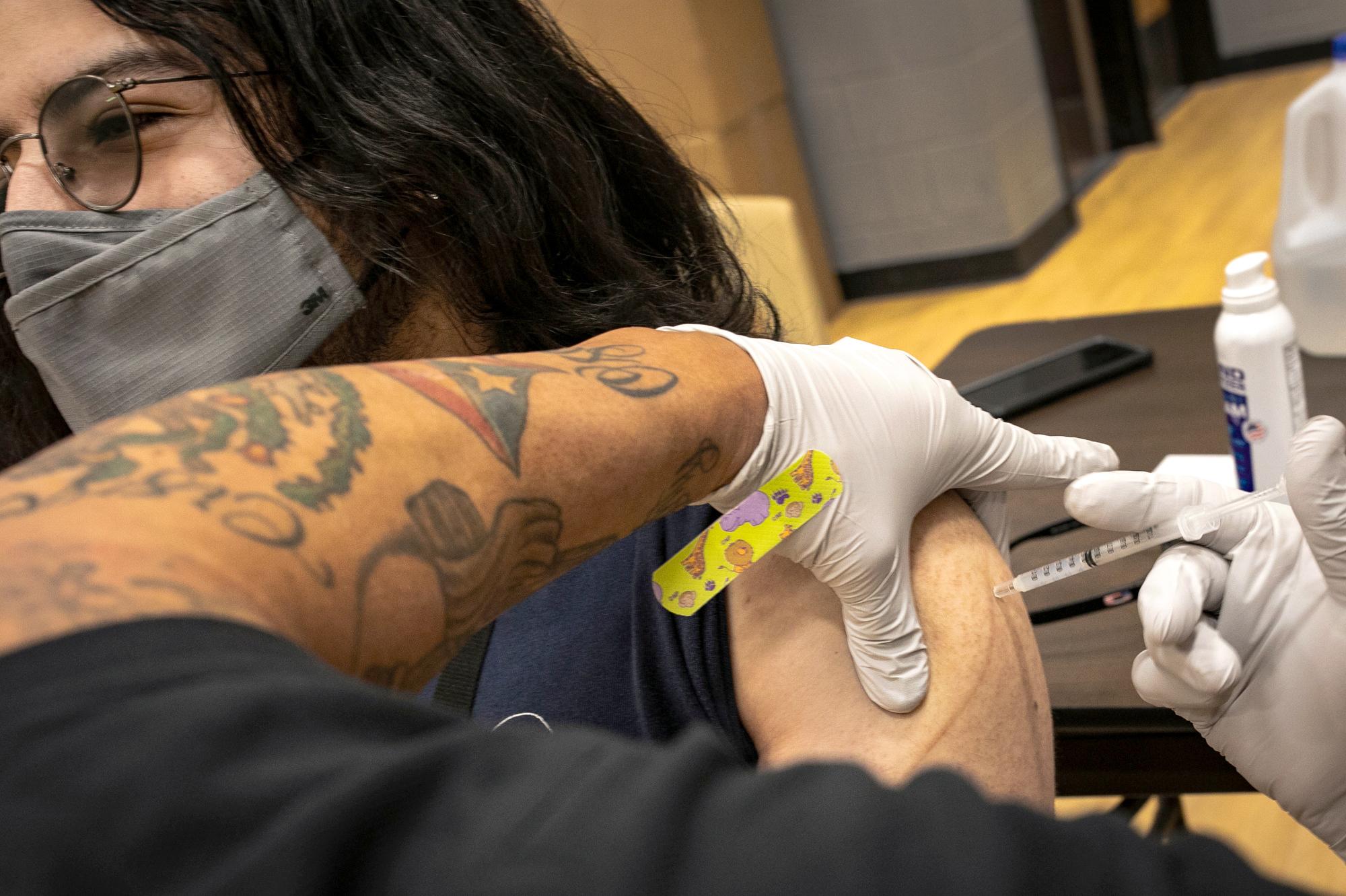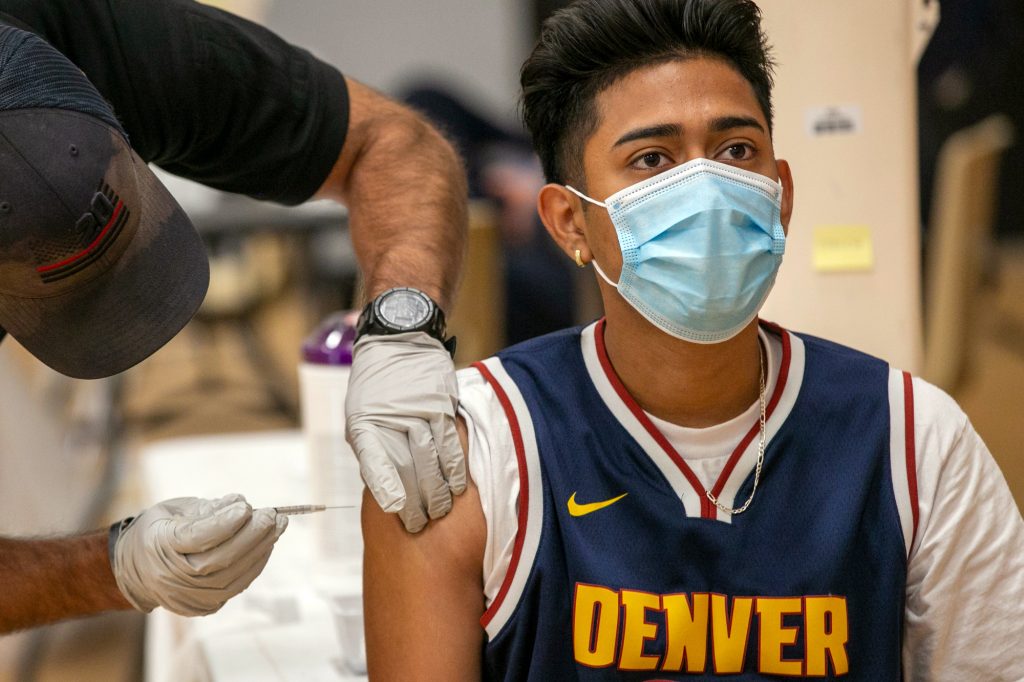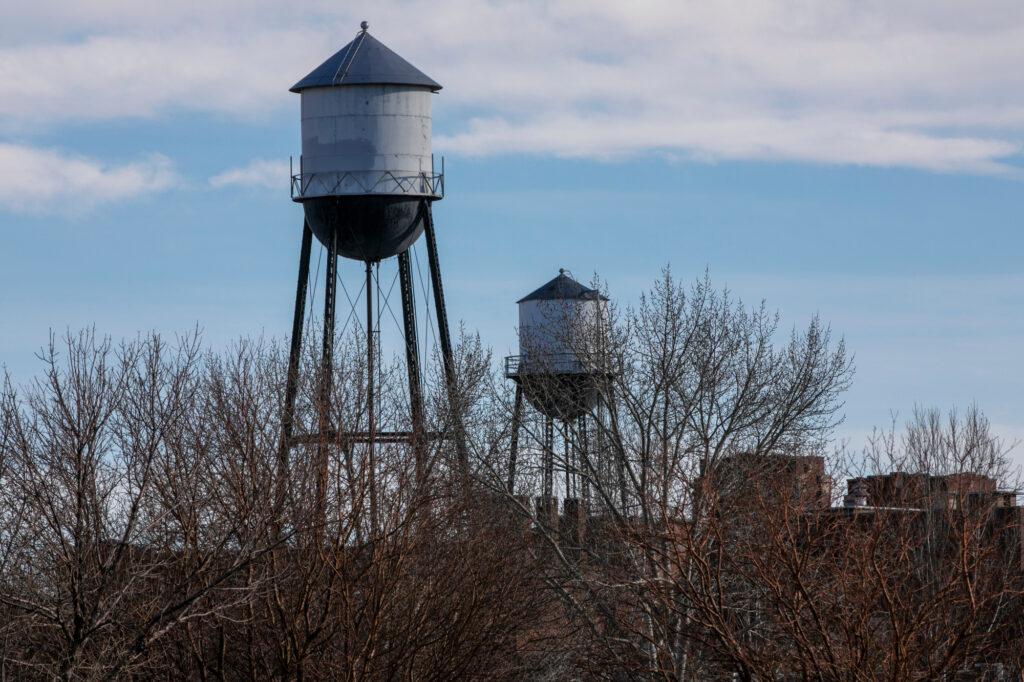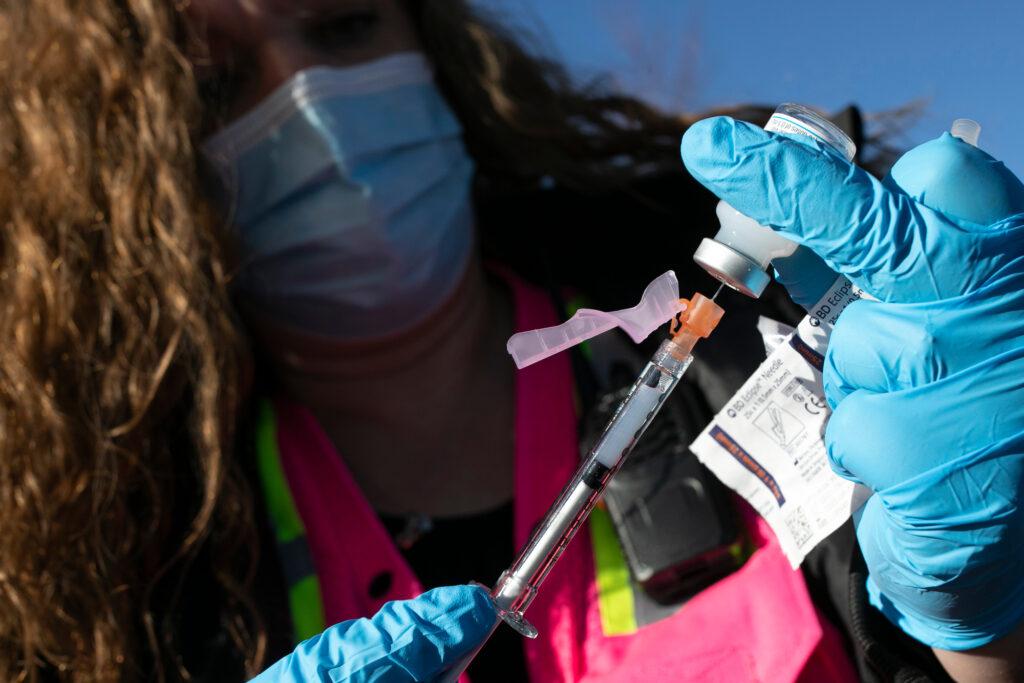
Gabriel Huitron sat in the post-shot observation area of the high school gym at Dr. Martin Luther King Jr. Early College in northeast Denver. He had just been injected with his first dose of the Moderna vaccine.
Getting the vaccine was not a step he took lightly. He was skeptical about it at first, but said that the fact that a pair of his uncles contracted COVID-19 and had to be hospitalized pushed him toward protecting himself from the coronavirus. That, and a desire to avoid any future quarantine orders.
“I didn't try to get a vaccine beforehand, but it came up to me about five days ago,” Huitron said. “I've had a good amount of relatives throughout my family contract COVID and quarantine sucks. No one wants to be alone in the house for a month.”
Brizan Guthrie came to the vaccine site too. The Metro State University student was the last person in her household to get the shot. She’d tried to get an appointment before, but was unsuccessful.
When asked if she had any questions or doubts about getting the shot, Guthrie said “not really, no. I just thought it would be the best decision to get it done instead of not doing it and then risking getting COVID.”
- Your Always Up-To-Date Guide To Finding The Info You Need
- Where can I go without an appointment? These 6 Colorado COVID Vaccine Sites / Denver's Community Vaccination Sites (via Denverite)
- Can I get time off work to get my shot? Colorado Employers Have To Give Paid Time Off For COVID-19 Vaccinations
- What happened with the Johnson & Johnson vaccine? Anxiety — Not The Johnson & Johnson Vaccine — Caused Reactions In Colorado, CDC Says
- What if I work at or attend a university here? Most College Students, Faculty And Staff In Colorado Will Need A COVID Vaccine Before Going Back To Campus In The Fall
Vaccination rates are lagging for Latino and Black Coloradans, as well as for men.
These two are exactly the kinds of people the state is hoping to reach now. They’re both young — he’s 22, she’s 18 — and from groups — Latinx and Black Coloradans — whose vaccination rates lag behind their share of the population.
But at least so far on this day last week at this site, they don’t have a lot of company. Nurse Hayley DeForest said it’s been pretty quiet.
“Demand, I feel like has gone down a little bit,” De Forest said. “It's just trying to figure out who still needs vaccines, because obviously, we have not vaccinated the entire population.”
As of Monday, nine percent of those vaccinated in Colorado were Latino, though they comprise almost 22 percent of the state’s population.
Roughy, 2.6 percent of those vaccinated are Black Coloradans. That’s less than their nearly 4 percent share of the population.
Another key group showing lagging vaccine numbers: men. So far, women make up 53 percent of those who have been vaccinated in Colorado, compared to just more than 46 percent for men.
That could partly be accounted for by increased longevity among women at the ages that first got access to the vaccine, but national polls have shown the most hesitant group in the U.S. are Republican men. White Coloradans make up 70 percent of those vaccinated, about 2.5 percent higher than their proportion of the population.

A lot more appointments are available, pointing to more vaccine hesitancy.
Gov. Jared Polis said he didn’t see resistance to vaccines in general. He pointed to state research showing “the vast majority of Coloradans, upwards of 80 percent, are willing to get the vaccine, are interested in getting the vaccine. It's only a small percent that's actually resistant to it. But for many of them, it is a matter of hesitancy or laziness to get it.”
But the availability of appointments really tells the story. The state’s 1,381 vaccine injection providers are now awash in available appointments and mass vaccination clinics have started accepting walk-in patients.
All with only around 40 percent of the state’s eligible population now fully vaccinated, just more than halfway toward the goal.
Vaccinations in El Paso County dropped recently as coronavirus cases rose locally. A mass vaccination site run by the federal emergency agency FEMA at the state fairgrounds in Pueblo saw the same.
“We've had a significant number of appointments available,” said FEMA spokeswoman Julie Brooks. “So keep it in mind that we can accommodate up to 3,000 a day if not a little more. And most days during the week, we run between two and 500.”
Brooks said between those who’ll never get a shot and those who already have are a large group she calls the movable middle, who still may have questions or lack access.
“There's probably about 25 percent or so that are just kind of, you know, hedging a little bit there,” said Pueblo County public health director Randy Evetts. “They think they will get it, but they just want to make sure that it's safe. And that it's convenient for them.”

Hospitalizations are on the rise, especially in areas where vaccination rates are low.
Evetts says nearly half of the eligible population in Pueblo County has taken advantage of at least one dose of the vaccine. That’s a figure below other large Front Range counties. And a lot of people are still getting sick. Evetts calls it “a sharp increase from where we were. It is what we're considering our fourth wave.”
State data show counties with lower vaccination rates, like Pueblo, are seeing higher levels of disease transmission and vice versa. Dr. Sandeep Vijan at Parkview Medical Center said Friday the hospital had 38 COVID patients.
He said if it adds just six more patients, the county would hit orange on the local coronavirus dial, forcing it to issue new capacity limits for businesses.
“We are teetering on the edge. We have been teetering on this edge for the past two weeks or so,” Vijan said. “Just to give you some perspective, all those patients who were in the hospital today, none of them are vaccinated.”
Most are in their 30s, 40s and 50s. Many are Hispanic and live with obesity, a key marker for severe illness.
Vijan said if hospitalizations continue at the pace they’ve been going, by late May Parkview will hit levels it saw in the brutal fall surge. Then, Vijan said, it was essentially overrun with coronavirus patients and had to transfer some elsewhere.
“The tragedy is many more people are going to die in Pueblo and the country around the world until we all embrace vaccination for the powerful tool that it is,” Vijan said. “And that is my big message to people out there that we don't have good treatment for this today.”
Rural areas continue to struggle with vaccine trust and hesitancy.
Michelle Mills, CEO of the Colorado Rural Health Center said she’d been told of concerns from rural residents about the “safety of the vaccine, kind of lack of trust of vaccines, personal choice, existing health conditions.”
She’d heard that about 60 percent of rural residents are looking to get vaccinated, with perhaps 40 percent declining to get a COVID-19 shot, which she said seemed consistent with the rural acceptance of the flu vaccine.
Dr. Kurt Papenfus, an emergency medicine physician in the small eastern plains town of Cheyenne Wells, said interest there had waned since vaccinations were opened up to the general public a few weeks ago.
“The perception of threat was never that high out here, and pretty much gone now,” said Papenfus via text. He also attributed the hesitancy to “a conservative population suspicious of government ‘telling them what to do.’”
The major task ahead to get more people vaccinated will require perseverance, plus creativity and innovation, said Dr. Oswaldo Grenardo. He’s chief diversity and inclusion officer at Centura Health, which has been running a number of vaccine sites.
“A lot depends on how aggressive we are and what the messaging is for those people who are still left to get us over that hump,” Grenardo said. “It's going to be a much more difficult road this last leg of this race.”

The future of vaccination efforts in Colorado might focus on gaining the trust of small communities.
The final push will look different from the effort so far, said Dr. Anuj Mehta. The pulmonologist is part of a vaccine equity task force with the group Immunize Colorado.
“That takes us away from ‘let's vaccinate 6,000 a day’ to ‘Let's target a very small community. Let’s gain their trust. Let's make the vaccine available to them and answer their questions,’” he said. “And so maybe through that relationship will vaccinate 200 people in this very close knit community.”
That means more equity pop-up clinics, and targeted education events. As an example, Mehta said he recently gave a vaccine talk to a community group: the Colorado Center for the Blind.
“You need to start targeting specific populations for education to meet them where they are, understand their concerns, educate them as best as possible and try and help them make the right decision for them,” he said.
That message resonated in the high school gym in northeast Denver. This COVID-19 drive was organized by Black LIves Matter 5280, in partnership with Denver Public Health and Environment. BLM’s Ariel Lipscomb said she’s not disappointed by the turnout.
“I think after this first one, we'll have more success once people realize that we're not going to give up,” she said. “We're going to still be here for you and this will be available.”
Lipscomb, who is a Black resident of Denver, said she had initial reservations about getting the vaccine but eventually decided to get it.
“The apprehension in our community is real and valid, but at the end of the day, I did my research. I made an informed decision and chose to go forward,” she said.
And she said she’s confident, with time, many more Coloradans of all kinds will do the same.
But the clock is ticking. Hospitalizations were up 29 percent over the last two weeks before finally starting to flatten and Colorado’s case numbers last week rivaled that of California.









